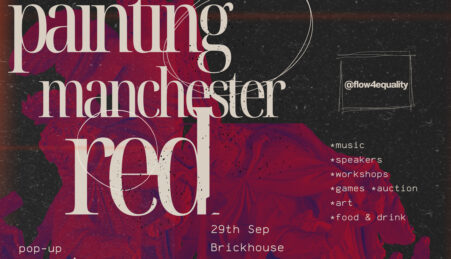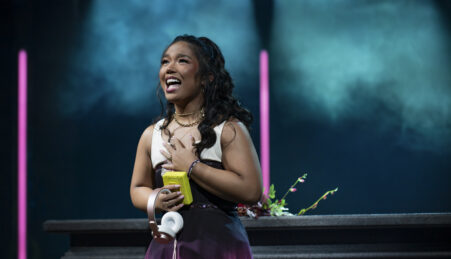By Helena Tomlinson
Students from the History, Politics and Philosophy department (HPP) at Manchester Metropolitan University flew to Berlin last week for the first international departmental trip. 11 students (including myself), along with members of staff from the department, spent four days in Germany’s vibrant capital city. The trip followed on from a successful visit last year to London and the Houses of Parliament organised by Matthew Barnard, Student Experience Officer.
The evening we arrived, we headed down to Alexanderplatz to explore what Berlin had to offer. Alexanderplatz is one of the main hotspots for those visiting Berlin as it has many sights to see and is always a hub of activity. Fernsehturm (TV Tower, the tallest building in Berlin), the colourful World Clock and the beautiful fountains of Alexanderplatz provided us with entertainment for the evening. Berlin is also renowned for having great food from all different cultures, which made deciding where to eat a tricky task as we were spoilt for choice. In the end, a few of us decided to eat at an Asian noodle bar, which offered a great taste of South Asian cuisine. Others opted for a more German style cuisine of wursts and kebabs – which are a million times better than the ones you would get on the way home from a night out! A particularly popular dish amongst the students was currywurst, a traditional German sausage topped with ketchup and paprika.
Throughout our time in Berlin we were met with beautiful weather, perfect for the day of sightseeing we had in store. The day began with heading to the fashionable district of Charlottenburg (great for anyone wanting to indulge in some shopping), where we were picked up by a lovely host for our Bus Tour of Berlin. We visited the Embassy District where we saw some of the most extravagant buildings, old and new, some considered great pieces of modern art. The guide told us a legend of the Embassy District, that the Italian Embassy has no fences or guards as it is protected by the Mafia. Although this legend is most likely a myth, I would like to think it was true. The tour continued round to Museum Island and down Unter den Linden. Allan Mandindi, a second year Politics student, said: “My favourite bit of the trip was the tour bus because it gave us the opportunity to see Berlin’s famous landmarks like the Cathedral and other important places such as Check Point Charlie.”
After our whistle stop of Berlin’s famous landmarks we grabbed some lunch. As the original plan of going to the Reichstag fell through, as they had VIPs visiting (possibly something to do with the end of the G7 summit that was taking place), we split into groups to visit different places. One group went to Museum Island and visited some of the many museums Berlin has to offer. Museum Island is a sight to see in itself as it is a UNESCO World Heritage site because of its wonderful old architecture and the main cathedral that is situated there. The rest of us went on an exploration of the City. Our walk took us past some of Berlin’s iconic sights such as: The Reichstag, Bundestag, Tiergarten, Venus Basin, Brandenburg Gate, The Holocaust Memorial, The Communist Memorial and Berlin Hauptbanhof. Berlin has many walking tours and is a perfect city for getting around as many of the sights are within walking distance.
Once we regrouped, we travelled to the district of Friedrischshain where the East Side Gallery is situated. The East Side Gallery is where remains of the Berlin wall have been left since it fell in 1989 and is decorated by artists depicting different scenes. Some of these relate to the time when the city was divided while others are stunning pieces of modern art. Many of the works were fascinating and provide an insightful perspective of life under soviet rule. Once we had walked the length of the East Side Gallery, we ventured down to the area of Prenzlauer Berg, where we found a spectacular secret beer garden that gave us the chance to try some of the many beers Germany has to offer. Any beer lover should head to Berlin as you will not be in short supply of it and there are hundreds of different flavours to try. My particular favourite is the Berliner Kindl Weiße, which came in a strange shaped glass and in either green or red coloured. We went for a bite to eat at the Anarchist restaurant that was recommend to us by Mark Sinclair, where we had a very tasty Italian meal.
The third day of the trip everyone visited the village of Oranienburg where the Sachsenhausen concentration camp is located. Sachsenhausen was one of the first concentration camps that existed alongside Dachau in the mid 1935s. It was later then used as a Soviet Work Camp after the second world war until the 1950s. Although much of Sachsenhausen is not how it originally was due to vandals and neo-nazis, there were still many buildings preserved. Within the camp there are memorials for all those who died under the Nazis and the Soviets. Matthew Barnard said: “The most important part of the trip for me was the Sachsenhausen Concentration Camp Memorial Tour. Our guide was excellent, and I think we were all simply stunned by what we saw. The group I was with were talking about it long into the evening, and a week later it’s still on my mind.”
Overall, the trip was a great success for the department and enjoyment for all the students and staff that came on the trip. Matthew Barnard said, “This trip is something that both the department and our students have wanted for some time, and I’m glad to have been able to get it off the ground. Trips like this are important, and not just for the obvious social benefit. They allow students to see politics and history incarnate. Being a city torn apart by the world wars and politics of the 20th Century, Berlin was an ideal place to go.”
Many of the students look forward to the announcement of next year’s departmental trip, and want to thank Matthew for the work he did organising the trip to Berlin.





Leave a reply